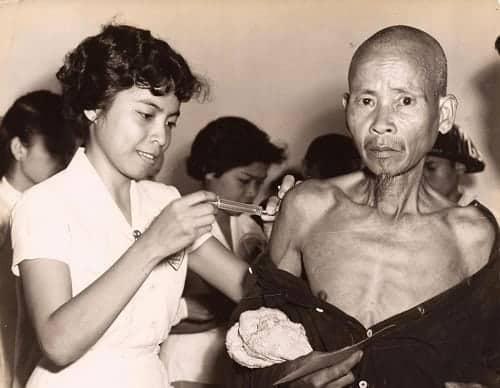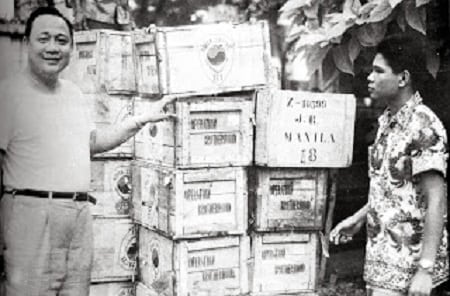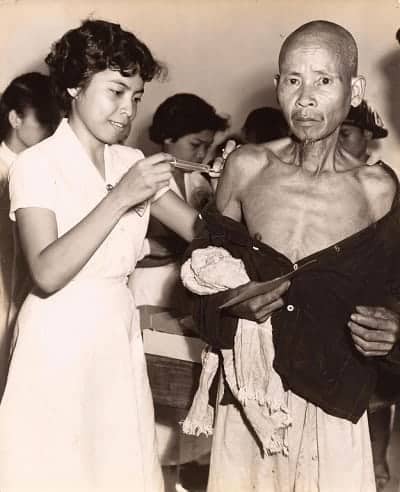A Touching Story of How Filipinos Saved A Million Lives At The Most Unexpected Place

Oscar Arellano saw it all.
As the president of the Manila chapter of Jaycees (short for Junior Chamber of Commerce), the Filipino architect had the chance to visit Saigon at the dawn of Vietnam War. After the Communists took over the north, thousands had fled to South Vietnam in search of refuge. But their government could only do so much; many people ended up homeless, starving, and in dire need of medical attention.
Arellano was deeply moved. He had to do something.
And so it was destiny that shortly after his return to the Philippines, his brainchild–a humanitarian project they christened “Operation Brotherhood”–was born. No less than Arellano’s friend, President Ramon Magsaysay, supported the initiative. Although part of the plan was to extend the services to the Filipinos, detractors were quick to discredit the project.
Why help foreigners when we couldn’t even address the medical needs of our own people?
But Magsaysay didn’t hesitate. The same quality that had endeared himself to the masses was once again exemplified, this time in offering our helping hands to other Asians struggling to survive. In Magsaysay’s own words:
“We have been assisted in our hour of need by generous friends. Shall we then deny our help to our neighbors when they are in need of it? Human misery knows no national boundaries. By all means, help them. And if there is anything that I and this government can do to help, please feel free to come to me.”
Magsaysay’s endorsement paved the way for many others. Originally sponsored by the Philippine Jaycees, Operation Brotherhood also secured the support from the group’s Asian counterparts. It later became a worldwide endeavor when it was picked as a major international project by the World Congress of the Jaycees.
Also Read: Pinoy “Schindler’s List”: How President Quezon Saved 1,200 Holocaust Jews
Adventures in Vietnam.
Aboard a Philippine Red Cross plane, seven Filipino doctors and three nurses flew to Saigon in October 1954 as part of the pioneering team of Operation Brotherhood. For two years, Filipino volunteers–which later ballooned to 195–rendered medical services and community development assistance to the Vietnamese refugees.
The Operation Brotherhood broke barriers. They had proven that neither wars nor religious differences could stop different nations from helping each other. The Filipino-led initiative enjoyed international support: volunteers and material aid poured from Japan, China, Hong Kong and as far as England, France, Australia, and the United States.
The Philippines may be a poor country, but it sent the most number of volunteers. They ranged from physicians, nurses, and nutritionists to agriculturists, mechanics, and fishery experts.

How the Filipino manpower led to the success of Operation Brotherhood is something that should never be forgotten. As said by Melgre O. Granada, the young volunteer who served as project manager in Vietnam (and later in Laos):
“Because the Filipino people were poor and could not give as much material or financial aid as other countries, their contribution of personal service was often undervalued. Yet the expenditure of human energy and dedication, sometimes even unto death, can be as great a contribution, even if it is not easily quantifiable.”
As with any philanthropic activities, the success of Operation Brotherhood didn’t come without a price. Three Filipinos–Dr. Jose Alejo, nurse Adela Pimentel, and nurse’s aide-cum-interpreter Yvonne Ocampo–lost their lives when their boat capsized in Waico River while on their way to a refugee camp in Tay-Ninh province.
Also Read: How to Become a Doctor in the Philippines

The deaths didn’t discourage Operation Brotherhood from finishing what they started. From 1954 until their final day in Vietnam on December 21, 1956, the Filipino-led humanitarian project treated and saved 730,000 people who lived in remote villages. Places that would have lost access to proper medical care and livelihood assistance were it not for people who extended their services without expecting anything in return.
READ: The Forgotten Story of Japanese Christians – Philippines’ First Refugees
Dramatic Encounters in Laos.
After Vietnam, Operation Brotherhood packed their bags and went to Laos to start all over again. Earlier, they were invited by the Lao Jaycees and the Prime Minister himself to transfer their services to their country. Just like Vietnam, Laos was a former French colony and was likewise involved in the Indochina Wars.
From 1957 until the new Communist government forced them to leave the country in 1975, Operation Brotherhood treated close to a million Laotians–from poor people living in faraway hamlets to members of the royal family. They also deployed a total of 450 Filipino volunteers, mostly on two-year contracts. Their programs were initially sponsored by the Lao government until the U.S. Agency for International Development took over in 1964.
The same holistic care they had given to the Vietnamese was enjoyed by the Laotian refugees. Not only did they receive quality medical services, but they were also trained on how to support themselves through livelihood projects ranging from carpentry and food preservation to farming and mechanical shop courses.
Slowly, the Laotians picked themselves up. Operation Brotherhood showed them that there was hope despite being caught in a war between pro-Communist troops and the right-wing forces. A damaging war that spared no one–even the Filipinos.
In an intense encounter in 1963, one Filipino was caught in the cross-fire. Bienvenido Natividad, a Filipino volunteer working at a hospital, sustained fatal gunshot wounds in the chest when the jeep he was riding with a Laotian was machine-gunned by the right-wing forces.
The Laotian suffered a minor wound in the thigh but survived. Natividad, who had married his sweetheart three months earlier, was not as fortunate. He died a few hours after being taken to the nearest hospital.
The risk of dying in a war-torn country was something that Operation Brotherhood had to deal with year in and year out. But as what the tragedy in Vietnam had proven to them, sacrifices were necessary in order to save as many lives as they could.
And saved lives they did. Sometimes even at the most hostile of places and using the most crude of tools.
One day, a Laotian patient was brought to the Operation Brotherhood’s makeshift clinic in the sleepy village of Paksong. The patient, accompanied by his American employer, showed symptoms that Filipino doctors later diagnosed as a case of a ruptured appendix.
Emergency surgery was needed. However, they were in the middle of the night with no electricity nor the facilities needed to perform the surgical operation. Worse, the nearest hospital was fifty kilometers away.
The two doctors–including Dr. Pedro Joaquin–weighed their options. Either let the patient die or proceed with the surgery despite the high risk of failure that would potentially alienate the whole community.
They chose the latter.
Soon after they made the decision, the room occupied by the Operation Brotherhood staff was cleaned, its floor scrubbed, and something was converted into an operating table. Several lamps were added to provide lighting, surgical instruments were boiled, and shirts to be worn by the surgeons were disinfected through ironing. A few moments later, the surgery commenced.
Thanks to their resourcefulness and a massive dose of antibiotics, the patient survived the ordeal. What they thought would lead to their ultimate failure turned out otherwise.
The news spread like wildfire and before they knew it, as much as 400 patients flocked to their clinic each day eager to be treated. The rising demand led to the construction of a 40-bed hospital in Paksong which was made possible by the combined contributions from the army, the community, and former patients whose lives were changed by the Operation Brotherhood.
Heroism Beyond Borders.
The legacy of Operation Brotherhood far outlived those who received the services they selflessly provided. It became a worldwide inspiration, so much so that Dr. Tom Dooley created the American and Japanese Peace Corps programs based on the framework of Filipino advocacy. It also received the first award for international understanding in 1958 from the prestigious Ramon Magsaysay Award Foundation.
And contrary to what its critics had pointed out earlier, Operation Brotherhood never forgot where it came from. The group was involved in the relocation of families living in Manila’s squatters area as well as resettlement of those affected by the 1965 Taal volcano eruption.
If there’s anything that Operation Brotherhood had taught us, that would be the comforting reality that we are all connected. That brotherhood and compassion for others go beyond national boundaries. And that we should stop caring about our differences and celebrate them instead.
After all, it was God himself who told us that loving our neighbors as ourselves is the second greatest commandment of all.
References
Bernad, M. (2002). Paksong. Budhi: A Journal Of Ideas And Culture, 5(3), 117-119. Retrieved from http://goo.gl/rLXk34
Ramon Magsaysay Award Foundation,. Operation Brotherhood – Citation & Response. Retrieved 16 November 2015, from http://goo.gl/Rv3O1Q
Reading Eagle,. (1967). Asians Aiding Neighbors in Operation Brotherhood, p. 53. Retrieved from https://goo.gl/49qf2S
Sarasota Herald-Tribune,. (1963). Fighting In Capital of Laos Open s Up Dangerous Crisis, p. 4. Retrieved from https://goo.gl/Yiazff
Thao Worra, B. (2013). Remembering Melgre O. Granada, Operation Brotherhood Pioneer. On The Other Side Of The Eye. Retrieved 16 November 2015, from http://goo.gl/eHHmiV
Witek, J. (1977). Reviewed Work: Adventure in Viet-Nam. The Story of Operation Brotherhood, 1954-1957 by Miguel A. Bernad. The Catholic Historical Review, 63(1), 67-69. Retrieved from http://www.jstor.org/stable/25020041
Written by FilipiKnow
FilipiKnow
FilipiKnow strives to ensure each article published on this website is as accurate and reliable as possible. We invite you, our reader, to take part in our mission to provide free, high-quality information for every Juan. If you think this article needs improvement, or if you have suggestions on how we can better achieve our goals, let us know by sending a message to admin at filipiknow dot net
Copyright Notice
All materials contained on this site are protected by the Republic of the Philippines copyright law and may not be reproduced, distributed, transmitted, displayed, published, or broadcast without the prior written permission of filipiknow.net or in the case of third party materials, the owner of that content. You may not alter or remove any trademark, copyright, or other notice from copies of the content. Be warned that we have already reported and helped terminate several websites and YouTube channels for blatantly stealing our content. If you wish to use filipiknow.net content for commercial purposes, such as for content syndication, etc., please contact us at legal(at)filipiknow(dot)net